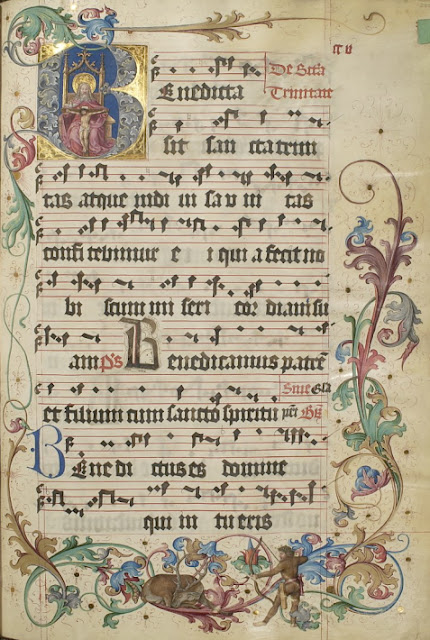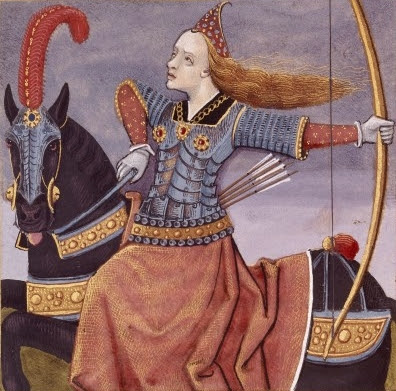By the name of it, you'd think it was another falconry manuscript like De Arte Venandi Cum Avibus, but it's actually a two volume liturgical book that was created in Germany between 1503 and 1510. It's called The Geese Book due to this illustration in the first book:
The volumes largely contain musical notation for chants with several very decorative illuminations. It's believed that one monk acted as scribe, whilst another chap was the artist. Having researched it a bit, I found out that this book is huge -- 25.75" x 17.5" -- and made of vellum with pigskin bindings. That's a lot of book, which doesn't sound massive until you see pictures:
The book contains a variety of chants for use at different times, some with some gorgeous illuminated margins and letters. Some of these chants are suggested for use at very precise days, such as the first Sunday in Advent, which, incidentally, has a really beautiful page, with a really odd illustration at the bottom:
Even after all these centuries, the gold on these pages is bright and looks absolutely stunning. The best example is a page with notation for chants on Trinity Sunday. The whole page is beautiful and in fantastic condition:
ACMRS has been digitising this manuscript since at least 2004. It became available online yesterday. I genuinely feel the need to thank the people who worked on this project for putting it online in this fashion. Without their work, I would never have lost myself in these two books which were created by two talented men. If you want to know more, examine the manuscript or even hear the chants (yeah, that hard work was part of the project too!), here's a link that'll take you straight to the online versions of the book: http://geesebook.asu.edu/volumes.htm. Enjoy!
Illustration from the bottom of a page showing a wolf leading a choir of geese, with a fox standing over them. Keeping the fowl singers in line? ...I'll get my coat...
The volumes largely contain musical notation for chants with several very decorative illuminations. It's believed that one monk acted as scribe, whilst another chap was the artist. Having researched it a bit, I found out that this book is huge -- 25.75" x 17.5" -- and made of vellum with pigskin bindings. That's a lot of book, which doesn't sound massive until you see pictures:
Left: The cover of volume II of The Geese Book. Sooo very pretty!
Right: Pictures of the book being digitised by the good people at The Arizona Center for Medieval and Renaissance Studies.
The book contains a variety of chants for use at different times, some with some gorgeous illuminated margins and letters. Some of these chants are suggested for use at very precise days, such as the first Sunday in Advent, which, incidentally, has a really beautiful page, with a really odd illustration at the bottom:
Bear and bear hunter in a bear hug. It looks oddly like a reconciliation rather than the bear attacking...
Even after all these centuries, the gold on these pages is bright and looks absolutely stunning. The best example is a page with notation for chants on Trinity Sunday. The whole page is beautiful and in fantastic condition:
Look how shiny that gold is! Also, I totally agree that the best time to shoot a deer with antlers like that is when it's asleep. For a higher res and zoomable image, check this page out.
ACMRS has been digitising this manuscript since at least 2004. It became available online yesterday. I genuinely feel the need to thank the people who worked on this project for putting it online in this fashion. Without their work, I would never have lost myself in these two books which were created by two talented men. If you want to know more, examine the manuscript or even hear the chants (yeah, that hard work was part of the project too!), here's a link that'll take you straight to the online versions of the book: http://geesebook.asu.edu/volumes.htm. Enjoy!





































